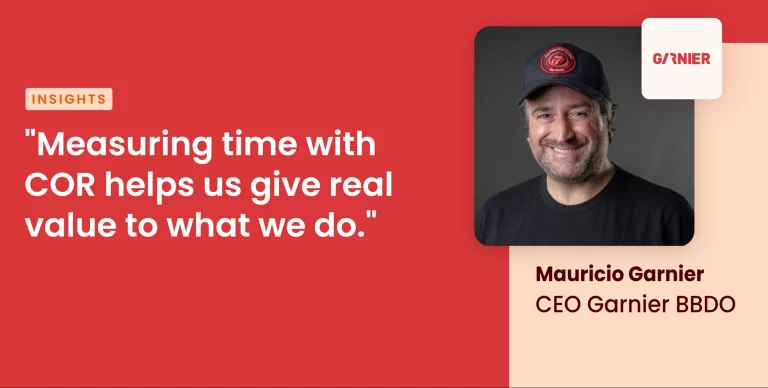Introduction
Data isn’t boring, scary or hard. It’s actually an essential part of growing your digital marketing agency. In this article, we’ll explore what it means to be data-driven, why it matters, and how to implement a data-driven culture within your business.
What does data-driven really mean?
Many digital marketing agencies claim to be data-driven these days. But what does that really mean? Well, put simply, a data-driven marketing agency uses data to guide its decision-making.
To help us understand, let’s take an analogy. We have two teams of social media marketers: team A and team B. They both post content for their clients to drive engagement.
This is what happens when you’re not data-driven
Team A’s current client is a software company with followers on Instagram and LinkedIn. They want to increase social media engagement to improve exposure and reach more potential customers. Team A is not data-driven, and being creatives they much prefer the visual and cultural appeal of Instagram. And so, while they post to both platforms, they spend more time and effort on Instagram because it’s what they most enjoy doing.
However, the data shows that, on average, their posts on LinkedIn achieve 10% engagement. While on Instagram, they barely reach 1%. Now, of course, this could be for several reasons: type of content, time of day posted, target audience, etc. You get the idea, there are lots of variables.
Now as team A isn’t data-driven, they don’t look at the metrics. Instead, they carry on doing what they do: posting whatever they feel like on Instagram because it’s what they most enjoy and it’s what they think will work.
Needless to say, this isn’t working out for the client as they aren’t getting the results they want. With 10% engagement on LinkedIn vs just 1% on Instagram, it doesn’t take a genius to figure out that the former will yield better results. And so the client stops working with team A, and instead hires team B to help deliver their strategy.
This is how data-driven agencies get much better results
Team B loves data. And so, instead of just posting what they feel like, they use metrics to guide them to achieve their client’s goal of increasing engagement. This means they focus their efforts on LinkedIn, as the data shows them this is where they’ll see a quicker outcome. They analyze which type of content gets the most engagement and which doesn’t, and then use these insights to create content going forward. For example, they find that polls get much more engagement than photos, so they post more polls and fewer photos to improve results.
And it doesn’t just stop with LinkedIn. Data-loving team B uses stats from Instagram to help them figure out why engagement isn’t great and what they need to do to fix it. Their research shows them that reels get more likes and comments than ordinary posts, and so they start pumping out reels on Instagram.
This optimization, on both platforms, allows them to continually improve and get better results. And that means a happy client. And it’s all thanks to their data-driven approach to decision-making. They take the data, analyze the trends and then use the information to devise a marketing strategy.
Data is everything
Today, it’s not just marketing agencies that use data to drive their commercial strategy. In the past few years, businesses big and small have invested large sums into data analysis.
Figures help in-house marketers to understand what their potential customers want and how they can improve their customer experience. For example, data allows them to track the success of a PPC campaign and to decide the most relevant ad words for future marketing campaigns. Data sources like Google analytics allow digital marketing agencies to see whether their content marketing strategy is working or not, by using statistics like website bounce rate and conversion rates. They can improve their rankings by looking at search engine data for different search terms. In short, analytics tools and customer data are essential to marketing optimization.
10 ways of building a data-driven culture
So we know what being data-driven means and why it’s important. So how do we create a data-driven culture within our agency? Well, here are our top 10 tips to get your teams to love data.
Involve the whole organization in data.
It’s not just marketing teams who need data, but every member of a business. For example, sales teams rely on KPIs to see who their best salespeople are. This allows them to share best practices from their top performers, which helps the rest of the team to improve their sales. And as with any change in a business, it needs to come from the top down, so company bosses need to be on board with the new number-based culture. After all, they’re the ones who call the shots.
Use the right analytics tools.
Technology is essential in driving data analytics in your company. The great thing about internet marketing is that everything can be measured. And so marketing agencies need a solid analytics tool that takes all the numbers from data sources and presents them in a way that’s easy to interpret. For example, Google Analytics allows marketers to measure landing page conversion and bounce rates. While Adwords helps marketing teams to assess the effectiveness of keywords and improve their search engine ranking. Data is a key part of any SEO and content strategy.
Get buy-in.
As with anything new, effective change management is essential if you want to drive data usage in your business. Your marketers need to understand why we analyze customer data like demographics and target audience. You want them to see how it can help their decision-making and assist them in developing an effective marketing strategy. To do this, it’s helpful to use case studies of when data has helped improve results. Seeing for themselves how analyzing numbers can improve results will get them on board. This is especially true for creative marketing teams, who are naturally averse to numbers.
Train your teams.
Similar to getting buy-in, it’s important to educate your digital marketing teams on how to interpret numbers and how to use analytics and CRM tools. If they know how and why they’re much more likely to use the data to guide their decision-making. Again this is important within creative teams. Let’s take content writers, who are naturally more interested in words than numbers. Data is useful for them to see which of their articles gets the most page visits, shares and comments. They can then use this data to help them shape their future content strategy by seeing what’s currently getting results.
Know what to measure.
Internet marketing affords a whole range of numbers, from customer data to real-time analytics. And with such a plethora of options available, it can be overwhelming to know exactly what to focus on. So, it’s important to streamline your marketing efforts and focus on some core KPIs to drive results. Knowing what metrics to track will depend on your objectives and your clients. For example, an e-commerce company will want to track traffic from PPC campaigns. While a social media agency would use post insights to help them understand each platforms’ algorithm.
Ensure transparency and avoid data silos.
In traditional marketing teams, data analysis is typically left to senior managers, while ordinary team members carry on with their creative tasks. But, to ensure effective use of data within your organization, all marketers, and employees for that matter, need to have access to the numbers.
And they also need to share their data with the rest of the organization. Otherwise, this lack of transparency will lead to dreaded information silos. This is where teams or groups within an organization keep the data to themselves.
Why is this risky for a business? Let’s take an example. A digital marketing company has a problem with staff retention, their marketers don’t stay within the organization. And this means managers are constantly recruiting and training new staff, which drains their time and has a negative impact on the customer experience. So the HR department needs to start sharing data, like results from employee satisfaction surveys, with the marketing managers. They’ll then analyze the data from HR to help them improve staff retention in their teams.
Set KPIs and targets.
KPI stands for key performance indicator and is effectively a benchmark number to measure performance. For example, in an e-commerce business, a core KPI would be their conversion rates – i.e what percentage of page visitors end up buying. For a blogger, an important KPI would be the bounce rate and the number of page shares, as this helps them to see the most and least popular types of posts. And in email marketing, open rates are an essential KPI. By deciding what our key performance indicators are, we can focus on what most drives results. And by setting targets, you’ll be holding your digital marketing teams to account.
Make it fun.
Let’s be honest, if you’re creative, numbers and reports are likely to have you zoning out in team meetings. Why pay attention to something boring when you’re busy with fun tasks like content marketing? So, to help with acceptance and buy-in, managers need to get creative and make using data a fun task. There are several different ways in which this can be done. For example, managers could set a competition based around lead generation for their teams. Or they could share league tables in weekly meetings or newsletters. If you’re office-based, using whiteboards to display stats is another way of making data more fun and entertaining. With many marketing agencies being full of creatives, making the numbers fun is essential to building a data-driven culture.
Track everything.
If you’re an SEO agency, you’ll want to measure your search engine figures and all the data that feeds into your current objectives. And so if you specialize in search results, why would you care about measuring your email marketing data? You’d likely be tempted not to measure those stats, and just focus on what will get you results right away. But, that’s a very short-sighted approach because if you’re measuring data and optimizing accordingly, then in theory your business will grow. While just as an SEO agency today, you could grow into a full-service digital marketing agency tomorrow. And then, all that data you don’t think is relevant right now, will suddenly come in very helpful in developing your future marketing strategy and segmentation.
Use the data.
This may sound like a very obvious point, but you’d be surprised. There are lots of businesses that invest large sums of money into data sources and analytics tools, but don’t do anything with the stats. As we’ve discovered already, the purpose behind recording data is to use it to make informed decisions and improve the businesses’ performance. For example, if you’ve got high conversion rates but low traffic, then that tells you there’s SEO work needed. If your email marketing campaigns have low open rates, is your copywriter coming up with subject lines that get people to open their emails? Or could it be the time of the day the emails go out? Using the data to guide your decision is essential for optimization.
The benefits of a data-driven culture
So, we know what data-driven really means. And we know how to build a numbers-based culture within our business. But aside from the obvious points of optimization, increased revenue, and customer retention, what are the key benefits?
- More revenue. This is the obvious point that’s been a theme throughout this article. Measuring data allows us to see what works and what doesn’t. And this allows us to optimize our efforts and get better results: increased traffic, higher conversions, more signups, etc. And in most businesses, all these metrics lead to one key goal: more revenue to invest in growth.
- Increased employee engagement. By sharing data and stats with the whole organization, team members can see very clearly where their efforts fit into the bigger picture. And data allows us to set individual and team targets, which empowers employees to achieve results, as well as holding them to account.
- Increased employee motivation. While creatives are naturally more inclined to ignore numbers and statistics, sharing figures that are relevant to their work is an excellent way of boosting morale. If you’re a content writer, you’d love to know if one of your posts suddenly gets 50% more page shares than previous articles you’ve written. If you’re a social media specialist, seeing a post with a 30% engagement will also be a huge confidence boost.
- It shows your stakeholders you’re a serious business. As I mentioned earlier in the article, data is everything. And so, if you’re looking for investors or clients, being a data-driven agency is essential. To your investors, it shows you know where your business is at, and where you want to be. And to your customers, showing them your case studies of previous data-related successes is a powerful way of convincing them to work with you.
Conclusion
The word data often conjures up boring images of analysts, reports, and dashboards. And if like many within the industry, you’re creative-minded, you may be attempted to switch off when you hear “Google Analytics”. But, as we’ve explored in this article, using data to guide your decision-making is an essential part of growth marketing. By using data to inform our decisions, we can optimize our current marketing efforts to get better results for our clients and ourselves. Building a data-driven culture takes time, but by following the tips in this article, you’ll soon start to see results.















